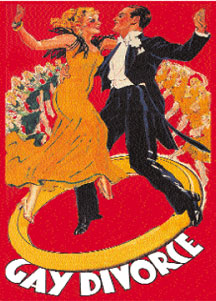
From Broadway To 52nd Street
The stage of the Ethel Barrymore Theatre opened its curtains on November 29, 1932 to the Gay Divorce. The musical starred once again Fred Astaire, this time in his last Broadway show, and teaming up with Claire Luce and Erik Rhodes. Although Gay Divorce ran for only 248 performances, Night and Day, composed by Cole Porter, emerged to become a jazz classic.
The Story: In this musical unfolds the story of a husband and wife who are having marital difficulties and in an effort to give her husband grounds for divorce, Mimi Pratt arranges to be caught with a paid co-respondent, by the name of Tonetti. But a young man named Guy falls for Mimi and manages to get himself confused with Tonetti; yet, amidst the confusion he pursues his courtship.
Broadway History: The theatre on Madison Square at the end of the 19th century was located at the intersection of Broadway and Fifth Avenue at W. 23rd Street. The Flatiron Building now occupies the site. By midway through the following decade, the street blazed with electric signs as each theatre announced its shows and stars in white lights. By the turn of the 20th century the street had an entirely different look with as many as sixteen theatres on Broadway itself and many others located on side streets or other avenues.
Broadway became much more than a mere twelve blocks. It started at 13th Street and wound its way a mile and a half up the avenue to 45th Street ending in the heart of Longacre Square. The first decade of the century also saw the construction of many theatres, most notably The New Amsterdam on 42nd Street in 1903 along with four others the same year that are still standing today. Longacre Square had the first moving electric signs and it was when the Times Building was erected in 1904 that Longacre Square ceased to exist. It was now known as Times Square.
Sponsored By
www.whatissuitetabu.com
More Posts: broadway


